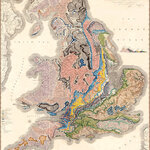Geology

New details of a nightmare period on Earth with surface conditions as frigid as present-day central Antarctica at the equator have been revealed thanks to the publication of a study of ancient glacier water.
The research, by an international team led by Daniel Herwartz, is published in the journal Proceedings of the National Academy of Sciences and shows that even tropical regions were once covered in snow and ice.
In the most recent ice age, the last glacial advance (ending about 12,000 years ago) ice sheets extended across Europe at the latitude of southernmost England and reached south of…

The same processes that determined how continents were generated on Earth more than 2.5 billion years ago have continued within the last 70 million years - and they profoundly affect the planet's current life and climate.
A new study details how relatively recent geologic events , namely volcanic activity 10 million years ago in what is now Panama and Costa Rica, hold the secrets of the extreme continent-building that took place billions of years earlier. This provides new understanding about the formation of the Earth's continental crust, the masses of buoyant rock rich with silica, a…

One canyon on Earth has two mouths - but that is not the only mystery.
First formally documented by western explorers mapping the Colorado Territory in the 1800s, Unaweep Canyon is a puzzling landscape
and so it has inspired numerous scientific hypotheses for its origin. A new paper published in Geosphere by Gerilyn S. Soreghan and colleagues brings together old and new geologic data of this region to further the hypothesis that Unaweep Canyon was formed in multiple stages.
The inner gorge originated ~300 million years ago, was buried, was then revealed about five million years ago when the…

The leading theory of what causes ice ages around the world -- changes in the way the Earth orbits the sun- has been cast into doubt by a new study.
The study raises questions about the Milankovitch theory of climate, which says the expansion and contraction of Northern Hemisphere continental ice sheets are influenced by cyclic fluctuations in solar radiation intensity due to wobbles in the Earth's orbit; those orbital fluctuations should have an opposite effect on Southern Hemisphere glaciers.
The researchers writing in Geology found that glacier movement in the Southern Hemisphere is…

The link between volcanism and the formation of copper ore could lead to discovery of new copper deposits.
Copper has been in use for 6,000 years and it shows no signs of slowing down. The average home has about a hundred pounds of it and we are going to have more people and homes, not fewer. Volcanoes may be the answer. A research team led by Professor Jon Blundy of University of Bristol's School of Earth Sciences, studied giant porphyry copper deposits of the variety that host 75 percent of the world's copper reserves. Copper forms in association with volcanoes such as those…

Vast ranges of volcanoes hidden under the oceans ooze lava at slow, steady rates along mid-ocean ridges.
A new study shows that they flare up on strikingly regular cycles, ranging from two weeks to 100,000 years, and, that they erupt almost exclusively during the first six months of each year because they are apparently tied to short- and long-term changes in earth's orbit and to sea levels. And so they may be helping trigger natural climate swings.
It is theorized that volcanic cycles on land are responsible for emitting large amounts of carbon dioxide that might influence climate but…

Published in 1815, Smith’s Geological Map of England and Wales and Part of Scotland was the first geologic map to cover such a large area in such fine detail. William Smith, British Geological Survey
By John Howell, Professor, Chair in Geology and Petroleum Geology at University of Aberdeen.
This year marks the 200th anniversary since William Smith published his life’s work, a geological map of England and Wales, in 1815.
While “Strata Smith” and his map are well-known among geologists, this humble man and his amazing map do not receive the attention or wider recognition they deserve. Smith’…

NWA 7034 -
Black Beauty
- is a meteorite found a few years ago in the Moroccan desert. Now it has been shown to be a 4.4 billion-year-old chunk of the Martian crust, and according to a new analysis, rocks just like it may cover vast swaths of Mars.
In a new paper, scientists report that spectroscopic measurements of the meteorite are a spot-on match with orbital measurements of the Martian dark plains, areas where the planet's coating of red dust is thin and the rocks beneath are exposed. The findings suggest that the meteorite, nicknamed Black Beauty, is representative of the "bulk…

The two hemispheres of Mars are dramatically different - more distinct from each other than any other planet in our solar system.
The northern hemisphere is non-volcanic, flat lowlands while highlands punctuated by countless volcanoes extend across the southern hemisphere. Although theories and assumptions about the origin of this so-called and often-discussed Mars dichotomy abound, there are very few definitive answers.
Using a computer model, a team of scientists concluded that a large celestial object must have smashed into the Martian south pole in the early history of the…

The Permian was a geologic period that ended more than 250 million years ago. The Earth consisted of one forested super-continent called Pangea and a large ocean called Panthalassa teemed with life.
It wasn't going to last, we know the largest mass extinction ever recorded was om the horizon. Why did it happen? The favorite hypothesis is that a series of massive volcanic eruptions deposited rocks now known as the Siberian Traps, released gases causing planet-wide acid rain showers that damaged the biosphere.
But there was no fossil evidence of this acid rain - until now. Rock samples from…